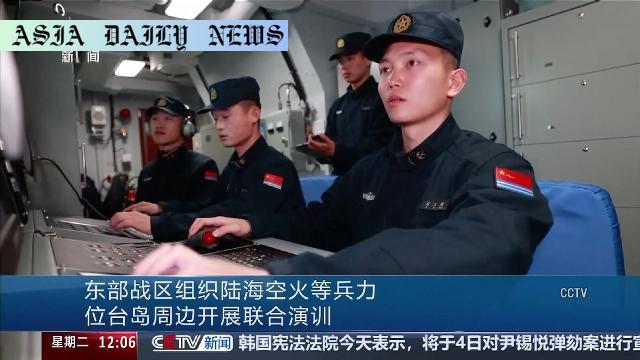Taiwan Strait: China’s military intensifies pressure with joint military drills near Taiwan, raising international concern.
- China conducts massive joint military drills around Taiwan.
- Exercises include air, sea, and ground target attacks.
- Taiwan’s government reacts, highlighting regional security erosion.
- Japan voices concerns over China’s actions in the Taiwan Strait.

China’s Military Drills: An Overview
China’s People’s Liberation Army (PLA) has conducted a series of high-intensity joint military exercises around Taiwan in what appears to be a deliberate move to maintain strategic and political pressure on the administration of Taiwanese President Lai Ching-te. The exercises, carried out by the Eastern Theater Command, featured coordinated operations among the army, navy, air force, and rocket forces. Activities included intercepting aerial targets, attacking land and sea targets, and practicing a naval blockade. These maneuvers underscore China’s growing military capabilities in the region and its unwavering stance on Taiwan’s sovereignty.
The Underlying Political Message
The timing and focus of these exercises suggest a calculated effort by China to intimidate the Taiwanese government. Describing the drills as a “stern warning” to separatist forces, China’s Eastern Theater Command explicitly declared the operations as essential actions to safeguard sovereignty. Taiwan’s President Lai Ching-te, who has long been viewed by Beijing as a pro-independence leader, recently referred to China as a “hostile external force,” further escalating tensions. By normalizing military pressure and demonstrating combat readiness around Taiwan, China aims to curb what it perceives as growing separatist sentiments under Lai’s administration.
International Reactions and Escalating Regional Concerns
The ripple effects of China’s military maneuvers extend far beyond the Taiwan Strait. Japan, for instance, has expressed grave concerns about the increasing instability in the Indo-Pacific. Chief Cabinet Secretary Hayashi Yoshimasa emphasized the importance of peace in the Taiwan Strait for international security, reiterating Japan’s resolve to closely monitor the situation. Meanwhile, Taiwan’s Ministry of Defense criticized China’s activities for undermining regional stability, spotlighting the nation’s ongoing expansion of its military presence in nearby waters. These reactions underscore the growing unease about China’s assertiveness in the region.
Broader Implications for the Indo-Pacific
China’s actions around Taiwan not only signal escalating tensions but also illustrate Beijing’s broader ambitions to assert control and challenge the established international order. The exercises highlight the risks of miscalculation or unintended escalation, particularly as countries like the United States and Japan maintain strategic interests in the region. The Taiwan Strait remains one of the most contested areas globally. China’s maneuvers, often accompanied by its coast guard’s patrols and inspections, raise questions about the international community’s capacity to effectively respond to such provocations while avoiding conflict.
Future Projections and Path Forward
As China normalizes its military activities near Taiwan, a crisis over the Taiwan Strait seems increasingly plausible. Striking a balance between deterrence and diplomatic engagement should be a priority for nations advocating for peace. On one hand, regional actors like the US and Japan must bolster defensive measures and maintain a presence to counterbalance China. On the other, careful diplomacy is needed to prevent a deterioration of ties that may lead to open conflict. For Taiwan, managing internal resilience while pursuing greater international support will remain critical in navigating this precarious geopolitical landscape.



Commentary
China’s Strategy: A Show of Force or a Prelude to More?
China’s recent military exercises around Taiwan are as much a demonstration of strength as they are a strategic message to both Taiwan and the international community. The normalization of such drills appears to be Beijing’s way of asserting its claims over Taiwan and signaling its readiness for more decisive actions should the need arise. This show of force is not only targeted at Taiwan’s pro-independence administration but also serves as a warning to external actors, including the United States, Japan, and other nations advocating for Taiwan’s sovereignty.
The Impact on Regional Stability
These drills pose significant questions regarding the security of the Indo-Pacific. Actions such as missile exercises, airspace incursions, and naval blockades are not just exercises in military capabilities but acts that test the patience and responses of neighboring countries. Regional players like Japan have voiced concerns, which reflect the growing anxiety about the potential for conflict. There’s no denying that China’s actions are reshaping the security dynamics in Asia, and it remains to be seen how the region’s major powers will adapt and respond.
A Balancing Act for the International Community
While China flexes its military muscle, the response from the international community must be measured yet firm. Sanctions, diplomatic calls for restraint, and strengthening alliances like the Quad (USA, India, Japan, and Australia) underscore the importance of a united front against unilateral actions that could destabilize the region. Simultaneously, nations must tread carefully to avoid exacerbating tensions, which could lead to unintended consequences. Maintaining peace and stability in the Taiwan Strait is as much about addressing China’s actions as it is about fostering dialogue, no matter how challenging it might be.